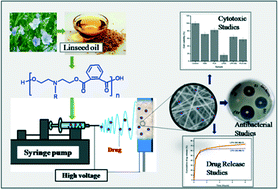Design and fabrication of mechanically strong nano-matrices of linseed oil based polyesteramide blends†‡
Abstract
New nanomaterials of bio-origin with improved mechanical properties are in demand for biomedical application. Therefore, we propose to design and fabricate bioactive nano-matrices with good mechanical strength using polyesteramides derived from linseed oil. Polyesteramide was synthesized from linseed oil and blended with poly(L-lactide) and human serum albumin to enhance the mechanical strength, biodegradation, biocompatibility and hydrophilicity. The various blend solutions with and without drugs (triclosan and metronidazole) were electrospun into non-woven nano-matrices. The morphology of the nano-matrices represented smooth and fine nanofibers with the diameter ranging from 300 to 400 nm. Drug binding efficiency, cytotoxicity, hydrophilicity, thermal and mechanical studies indicated their suitability as biomaterials. To demonstrate their utility, the drug release kinetics and antibacterial properties were evaluated. The metronidazole loaded nano-matrices showed drug release up to 8 h, beyond which no release was observed until 72 h. Antibacterial studies were done using the drugs triclosan and metronidazole. The antibacterial activity of the drug loaded nanofiber mats increased with the increase in drug concentration. The uniqueness of the developed nano-matrices of polyesteramide blends is that their mechanical strength is 3-fold higher than that of the nano-matrices of poly(L-lactide), which is one of the essential features of these nano-matrices to be used as a biomaterial for biomedical applications.


 Please wait while we load your content...
Please wait while we load your content...